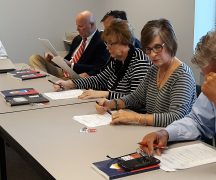By JAN LARSON McLAUGHLIN
BG Independent News
Bowling Green City Schools’ attempt to turn its 5-year income tax into a continuing levy will likely face two opposing schools of thought at the ballot on Nov. 2.
Those two lines of thinking were expressed Tuesday evening at the board of education meeting.
One woman said that by coming back to the voters every five years, citizens can keep a handle on how the money is spent.
“I don’t think the public has as much confidence with the powers that be,” she said. “Things are different.”
David Conley, financial adviser to the school district, explained the value of changing the income tax to a continuing model – rather than asking the same voters to approve the same money every five years.
“It ties the hands of the school district,” Conley said. “They have to always fear that you’ll say ‘no.’”
“That’s the way life is,” the woman said.
But that is like holding the same money hostage, Conley said, describing it as “Teach my kid – but I may not pay you to do it.”
Another woman at the meeting saw the issue differently. She asked how the school district could continue to do its job on the same tax revenue. That just isn’t realistic – so how can the district increase that amount, she asked.
Kisha Nichols, a second grade teacher at Kenwood Elementary, said the needs in the school district are dire right now.
“The needs of these kids are unlike anything we’ve seen before,” Nichols said. “Their needs are so high right now.”
Nichols suggested that local residents unhappy with the direction of the district express their feelings when voting for school board members – but not vote to take money out of the budget to educate children.
League of Women Voters member Char Scherer agreed that the needs are great right now. She mentioned a PTO fundraiser at the Middle School to help buy supplies for children whose families can’t afford them.
“There’s a great need in Bowling Green schools right now,” Scherer said.
Conley presented an overview of the income tax issue on the ballot. This will be the eighth time for district residents to vote on the 0.5% income tax since it was first passed in 1992. Passing it as a continuing tax will not increase the amount of money paid by residents. It will just keep the district from having to ask for the same $3.9 million every five years.
It used to be that “taxpayers felt they were keeping you honest,” by making districts come back to get the same amount of money, Conley said. But the current trend in education is voters realizing the benefits and voting to turn temporary levies into continuing levies, he said.
The benefits, Conley said, include reducing “voter fatigue,” cutting election costs, and freeing up the school district’s financial reserves.
Last year, school district voters approved changing two temporary property taxes into continuing levies.
Doing the same with the income tax will allow the district to spend more of its revenue rather than stockpiling it in case the voters reject a renewal, Conley said.
The district currently has $22 million in reserves that can’t be spent, he said.
“You end up with cash in the bank that you can’t use to educate kids,” Conley said.
If the income tax issue passes on Nov. 2, some portion of that $22 million will be freed up to expand educational services for students, invest in new or existing buildings, or reduce outstanding debt balances.
“It opens the door to a lot of conversations,” Conley said.
If the issue fails, the district will have two more chances to try again – in May and November of 2022. If it doesn’t pass then, the district will lose $3.9 million annually.





